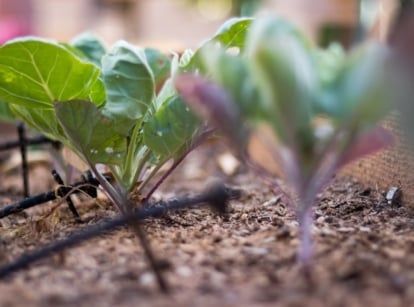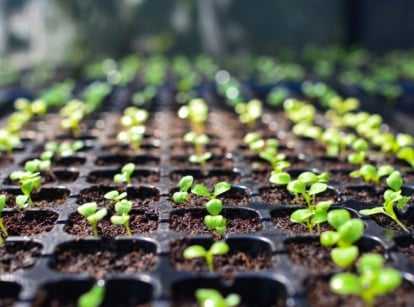7 Essential Checks to Perform on Your Drip Irrigation System in Spring
Spring is on its way, and that means it’s time to get your garden ready for a new growing season. Join farmer Briana Yablonski to learn how to get your drip irrigation system running smoothly after a winter’s rest.

Contents
Spring is one of the most exciting (and busiest) times in the garden. When birdsong fills the air and overwintered bulbs start poking out of the ground, I know my days will soon be packed with sowing seeds, transplanting seedlings, and keeping up with growing weeds.
While it’s easy to get caught up in fun tasks like building new raised beds and planting new perennials, spring is also the best time to check your drip irrigation system. Giving your system a once-over before dry days arrive means you’ll be able to water your plants when they need it.
Not sure where to start? No problem! I’ll cover how to check your drip irrigation system and ensure it’s ready for the upcoming growing season.
Connect Any Overwintered Components

If you live in an area where the temperature remains below freezing during the winter, you should bring irrigation components like timers, filters, and pressure regulators indoors. You should also disconnect faucets and hoses and drain any remaining water. These actions will protect your system from damage caused by water freezing and expanding.
When spring arrives, remove any components you stored indoors and reconnect them to your system. Make sure any connections are free from leaks and hoses don’t have any holes.
Check Timers

Using a hose-end timer is a great way to simplify the irrigation process. You can set the timer to run your irrigation system three times a day, every four days, and countless iterations in between. While I always recommend checking the system to ensure your plants receive the appropriate amount of water, timers allow for a more hands-off approach to watering.
While timers can simplify irrigation, malfunctioning systems can lead to dry or overwatered crops. Therefore, you should inspect your timer each spring.
If it runs on alkaline batteries, add new batteries at the start of the growing season. You should also reset the timer so your system runs at the appropriate intervals. After you have the settings where you want them, ensure water runs at the appropriate time.
Timers left outside during the winter often become damaged by the environment. If your timer isn’t turning on after you add new batteries, you probably need to replace it.
Clean Your Filter

Filters are an essential part of drip irrigation systems and must be checked regularly. They screen out dirt and other small particles that can build up and clog drip emitters. However, if you don’t clean the filter, scum and sediment can build up and clog your drip system.
Depending on your water source, it’s recommended to clean your filter anywhere from once a month to once a year. I always recommend cleaning the filter in the spring before you start putting your irrigation system through the paces.
Pro tip: Filters should always be downstream of timers and pressure regulators. Attach the timer to the spigot, followed by the pressure regulator and filter.
Remove the cap from the filter’s canister, then remove the filter screen. Rinse the screen with running water to remove any sediment or scum. Return the filter to the canister and replace the cap.
Inspect Points of Connection for Leaks

When you check and maintain your drip irrigation systems correctly, it slowly delivers precise amounts of water to your garden. This slow flow moistens the soil while preventing runoff and evaporation that can lead to wasted water.
However, with dozens of connection points, these systems are prone to leaks. Checking your system for leaks each spring will help ensure the water is flowing where you want it.
Check Threaded Connections

If you notice water leaking from your pressure regulator, faucet, or any other threaded connections, don’t assume that the connection is too loose. These attachment points should only be hand-tightened, so you don’t need to use a wrench. Instead, unscrew the parts and then reattach them.
The male and female threaded ends should easily screw together and form a tight seal. If they don’t, you may be working with incompatible parts.
Irrigation parts come in two types of threads: hose thread and pipe thread. The male and female ends of fittings must contain the same type of thread. If you try to attach a pressure regulator with a male hose thread (MHT) to a hose with a female pipe thread (FPT), they won’t connect smoothly. You can buy an adapter to connect these two parts or purchase a new hose or pressure regulator.
Check Tape and Header Connections

Drip irrigation systems rely on flat tape that slowly drips water into the soil, but you must check the tape regularly to ensure that it is functioning properly. The water must first flow through other hoses and tubing before it reaches these pieces of drip tape. In most of these irrigation systems, the drip tape connects to a header made of plastic tubing.
Since each piece of tape is connected to the header separately, each connection has the potential for leaks. Ensure that each adapter is tightly connected to the header—some adapters have twistable locking collars that you can tighten against the header.
You should also ensure the end of the drip tape is fully inserted into the fitting. Loosen the twisting collar towards the middle of the fitting, slide the drip tape over the barb, and then tighten the collar over the tape to secure it in place.
Check Drip Tape for Holes

If you left your drip tape in your garden over the winter, spring is a great time to check for cuts and holes. Rodents like mice and voles sometimes chew the tape, leading to ragged holes. It’s also possible that you unknowingly cut the material with a stray harvest knife or hoe.
While you can look for holes in an empty system, letting water run through the drip lines makes leaks easier to spot. Turn the system on, then look and listen for gushing water. Although large leaks are obvious, smaller holes are more challenging to find. If you notice an unusual wet spot after you run your system, check for a small leak.
If you find a single hole, you can use a coupler adapter to fix the problem. Turn off the impacted drip line, and then use a pair of scissors to cut out the portion of the tape with a hole. Attach both sides of the drip tape to the coupler, then tighten the screwable collars to secure the lines.
If a single line has multiple holes, replacing the entire line may be more cost-effective than fixing the leaks with couplers. Disconnect the leaking line from the header and then connect the new line.
Complete a Test Run

Once you’ve reconnected your parts, checked the connections, and repaired any leaking lines, it’s time for a test run. Turn on your water source and allow your system to pressurize. Go through the system from the water source to the end of the drip lines while checking for leaks and blockages.
If you spot any problems, repair them. This may involve tightening connections, fixing holes, or untwisting lines. You should also make sure water isn’t flowing off of your raised beds.
You can also check to see if all of the lines properly pressurize. If the lines aren’t dripping, there could be a few problems. While some gardeners assume there isn’t enough water pressure in the system, this is unlikely. A PSI between 10 and 30 will fully fill the lines unless you’re running a very large drip system.
Leaks, clogs, and an improperly installed pressure regulator are more likely. Ensure your pressure regulator is facing the correct way and properly connected. If it is, walk through your system again while checking for leaks and clogs.
Replace Any Worn Parts

While most parts of a drip irrigation system can last for multiple years, it’s important to check the system every year because improper storage and regular wear may require you to replace parts.
Stripped threads on fittings and connectors lead to leaks and require you to replace these parts. You may also need to replace drip lines after multiple years, once they begin cracking and splitting. The lifespan of drip lines depends on the thickness of the tape and environmental conditions.
After you replace these parts, complete a final test run of your system. It’s ready for the upcoming growing season if everything is running smoothly.









